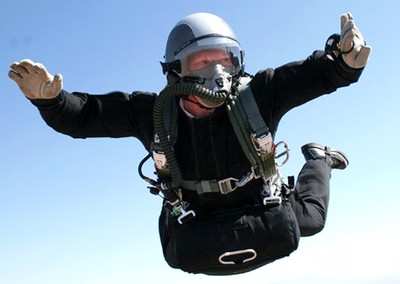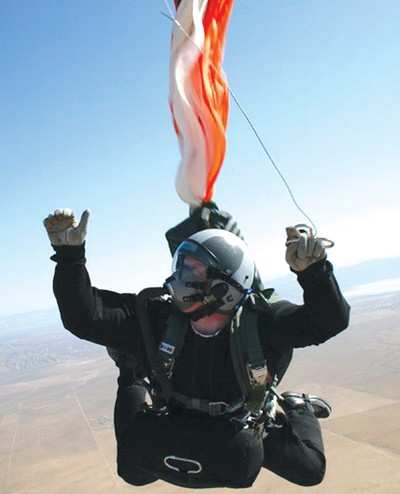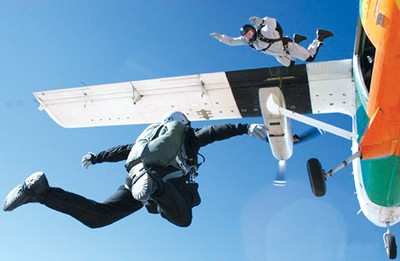It has been said there is no good reason to jump out of a
perfectly good airplane. But a small cadre of airmen at
California's Edwards Air Force Base have a very good reason to do
so -- saving lives.

These airmen don’t wear the maroon beret of the Air Force
Pararescue troops. Instead, they are members of the 418th Flight
Test Squadron’s test parachutist program, the only program of
its kind in the Air Force. They conduct developmental test and
evaluation on all Department of Defense aerodynamic deceleration
systems.
Master Sgt. Donald Wing, program superintendent, said the team
concentrates on all personnel parachute systems, aircraft ejection
seat systems, associated life support subsystems and aircraft
platform certification. The team has five survival, evasion,
resistance and escape, or SERE, specialists; one life support
technician; and three jumpers from the 412th Operations Support
Squadron’s SERE section.
"We’re here to test anything that might get jumped, bailed
or ejected out of an airplane," Sergeant Wing said.
Some of the team’s current tests include evaluating the
Joint Strike Fighter’s ejection system, and testing a gross
weight increase for the C-17 Globemaster III.
To perform evaluations on these systems, the jumpers must
maintain proficiency as test parachutists -- which means they have
to perform a minimum of 150 jumps per year.

"As a test parachutist, we have to be some of the best
parachutists in the forces," said Tech. Sgt. James Wright, NCO in
charge of test parachutist operations. "Not only do we test
parachute equipment, we also evaluate pieces of equipment and the
equipment used to conduct tests. We have to have our skills at the
top level, and we have to do things over and over again."
While there are dangers involved with the job, Sergeant Wing
said jumpers must be confident that a piece of equipment is going
to work before they put their lives in jeopardy. That includes
running new items through test parameters before parachutists
actually jump with them.
"We’ll do drags with a parachute or attach it to dummies
and throw it out of an airplane first," Sergeant Wing said.
"We’ll do that from numerous angles and airspeeds, trying to
encompass anything that might come up."
The jumpers also have backup chutes to get to the ground safely
if anything goes wrong.
"At times it’s a ball. At times it’s kind of scary,"
Sergeant Wright said. "You’re not going to force anybody to
be a jumper. You must have the desire, a love to do it. And when
you get into jumping, you realize some aspects are quite fun.
It’s one of those things that gets your heart racing. But
there are also tense moments. Sometimes parachutes don’t work
properly; sometimes they twist up."
Sergeant Wright said he recently had one of those tense moments,
when his parachute malfunctioned and he had to cut it away and rely
on his reserve chute.
"We have procedures for going to our reserve parachute," he
said. "If a parachute malfunctions, training takes over. You follow
procedures, take care of business. Then when you get on the ground,
you have time to think about what might have happened."

Sergeant Wing said the jumpers have to maintain currency with
more than 10 types of parachute systems.
"Because we’re jumping with a variety of new equipment
during a test, we also have to be able to tape or film what’s
happening in the air. That’s where our advanced freefall
skills come into play," Sergeant Wright said. "If we’re
filming, we have to be in the right place at the right time. We
have to practice when to exit. If somebody exits too soon or too
late, you’re not going to get it on film."
Life as a test parachutist is never boring, Sergeant Wing
said.
"There’s always something new coming down the line.
Something can always be done better; something’s always
getting approved," he said.
(Aero-News thanks Christopher Ball, 95th Air Base Wing
Public Affairs)
 ANN's Daily Aero-Term (04.26.24): DETRESFA (Distress Phrase)
ANN's Daily Aero-Term (04.26.24): DETRESFA (Distress Phrase) Aero-News: Quote of the Day (04.26.24)
Aero-News: Quote of the Day (04.26.24) ANN's Daily Aero-Term (04.27.24): Direct
ANN's Daily Aero-Term (04.27.24): Direct ANN's Daily Aero-Linx (04.27.24)
ANN's Daily Aero-Linx (04.27.24) Aero-News: Quote of the Day (04.27.24)
Aero-News: Quote of the Day (04.27.24)





